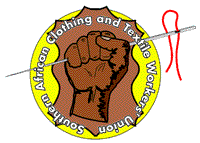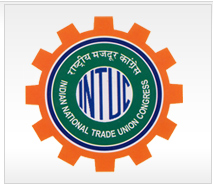This article does not cite any sources .(June 2019) (Learn how and when to remove this template message) |
Textile and clothing trade unions are labor unions that represent workers in the textile industry and garment industry. A partial list is as follows.

The textile industry is primarily concerned with the design, production and distribution of yarn, cloth and clothing. The raw material may be natural, or synthetic using products of the chemical industry.
International
- IndustriALL Global Union (Switzerland)
- International Trade Union Confederation (Belgium)
IndustriALL Global Union is a global union federation, founded in Copenhagen on 19 June 2012.
The International Trade Union Confederation is the world's largest trade union federation. It was formed on 1 November 2006, out of the merger of the International Confederation of Free Trade Unions (ICFTU) and the World Confederation of Labour (WCL). The Founding Congress of the ITUC was held in Vienna and was preceded by the dissolution congresses of both the ICFTU and the WCL. The ITUC has three main regional organizations – the Asia-Pacific Regional Organization, the American Regional Organization, and the African Regional Organization. The Trade Union Development Cooperation Network (TUDCN) is an initiative of the ITUC whose main objective is to bring the trade union perspective into international development policy debates and improve the coordination and effectiveness of trade union development cooperation activities.
Africa
- Southern African Clothing and Textile Workers Union (South Africa)

The Southern African Clothing and Textile Workers' Union (SACTWU) is the biggest union in the South African clothing, textile, footwear and leather industry, with more than 100 000 members. It negotiates wages for the vast majority of workers in these industries in South Africa, with the collective bargaining agreements covering over 150 000 workers.
Asia
- All India Jute Textile Workers' Federation (India)
- Bengal Chatkal Mazdoor Federation (India)
- Bengal Chatkal Mazdoor Union (India)
- Bengal Jute Mill Workers' Union (India)
- Bengal Provincial Chatkal Mazdoor Union (India)
- Bunkar Mahasabha (India)
- Coimbatore District Textile Workers Union (India)
- Federation of Chatkal Mazdoor Unions (India)
- National Committee of the Chinese Financial, Commercial, Light Industry, Textile and Tobacco Workers' Union (People's Republic of China)
- National Union of Jute Workers (India)
- Pondicherry Textile Labour Union (India)
- Powerloom Workers Union (India)
- Rashtriya Mill Mazdoor Sangh (India)
All India Jute Textile Workers' Federation, a trade union of jute mill workers in India. The union is affiliated to the Hind Mazdoor Sabha.
Bengal Chatkal Mazdoor Federation is a trade union of jute mill workers in West Bengal, India. The union is affiliated to the All India Central Council of Trade Unions.
Bengal Chatkal Mazdoor Union is a trade union of jute mill workers in West Bengal, India. The union is affiliated to the Centre of Indian Trade Unions. The general secretary of BCMU is Gobinda Guha and the president is Niren Ghosh.
Australasia
- Australian Workers Union (Australia)
- Clothing, Laundry and Allied Workers Union of Aotearoa (New Zealand)
- Textile, Clothing and Footwear Union of Australia (Australia)
- United Voice (Australia)
The Clothing, Laundry and Allied Workers Union of Aotearoa (CLAW) is a trade union in New Zealand. It has a membership of 750, and is affiliated with the New Zealand Council of Trade Unions.

The Textile, Clothing and Footwear Union of Australia (TCFUA) was a trade union in Australia. It represented a wide range of workers from the textile, clothing, footwear and felt hatting industries.

United Voice is a large Australian trade union, with over 130,000 members. United Voice members work in a wide range of occupations including hospitality, childcare, teachers' aides, aged care, property services, health, manufacturing, ambulance workers and community services. United Voice was formerly known as the Liquor, Hospitality and Miscellaneous Union (LHMU).
Europe
- Community (United Kingdom)
- Fédération française de la couture (France)
- GMB (trade union) (United Kingdom)
- United Federation of Trade Unions (Norway)
- Transport and General Workers Union (United Kingdom)

A community is a small or large social unit that has something in common, such as norms, religion, values, or identity. Communities often share a sense of place that is situated in a given geographical area or in virtual space through communication platforms. Durable relations that extend beyond immediate genealogical ties also define a sense of community. People tend to define those social ties as important to their identity, practice, and roles in social institutions. Although communities are usually small relative to personal social ties (micro-level), "community" may also refer to large group affiliations, such as national communities, international communities, and virtual communities.
The Fédération française de la couture, du prêt-à-porter des couturiers et des créateurs de mode is the governing body for the French fashion industry. The Federation was created in 1973, growing out of an older trade association, the Chambre syndicale de la haute couture parisienne which was created in 1868. The Federation comprises three separate trade associations:

The GMB is a general trade union in the United Kingdom which has more than 631,000 members. GMB members work in nearly all industrial sectors, in retail, security, schools, distribution and the utilities, social care, the NHS and ambulance service and local government.
North America
- UNITE HERE (United States)
- Workers United (United States)






